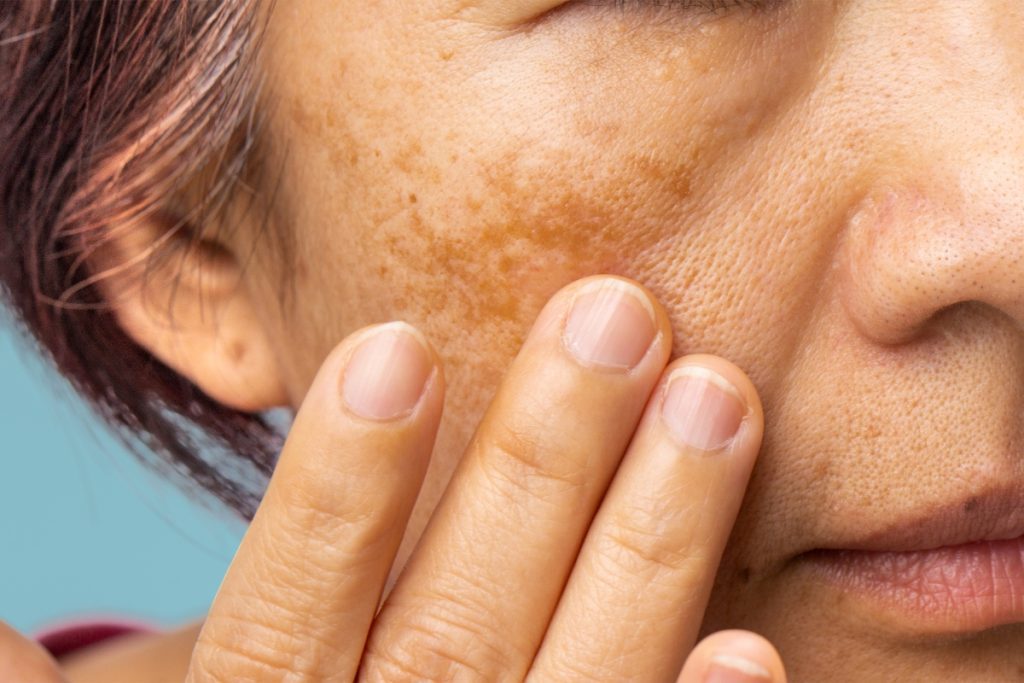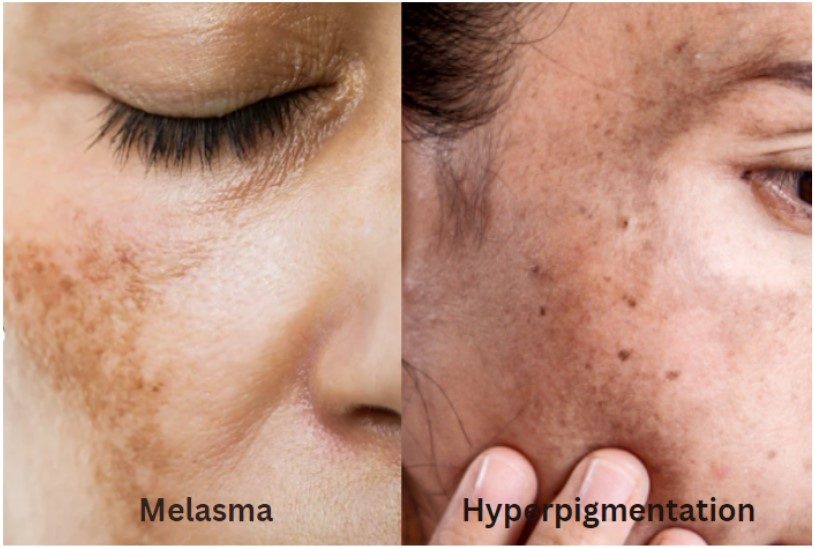What is Melasma?

Melasma is a skin condition characterised by dark, discoloured patches, most commonly seen on the face. This condition predominantly affects women, particularly those with darker skin tones. It’s often linked to hormonal changes, such as pregnancy, earning it the nickname “mask of pregnancy.” Despite its prevalence, the exact causes of melasma are complex and involve a combination of genetic, hormonal, and environmental factors.
What are the Differences Between Melasma and Hyperpigmentation?

While melasma is a form of hyperpigmentation and can both result in the darkening of the skin, their causes and appearances differ significantly. Melasma is often hormonally driven and has a symmetrical pattern, typically appearing on the face. It’s believed to be triggered by a combination of genetics, hormonal changes, and sun exposure.
Hyperpigmentation, on the other hand, can result from various factors such as inflammation, skin injuries, or acne, and can appear in localised or scattered patterns across the body.
Understanding these differences is crucial for treatment, as melasma’s underlying hormonal and genetic causes require a more specialised approach compared to the treatment of hyperpigmentation due to external skin damage.
What are the Common Causes of Melasma?
Genetics
Research shows a strong genetic link to melasma, with a higher predisposition among individuals of certain ethnic backgrounds. A family history of melasma increases the likelihood of developing the condition, indicating genetic factors that affect melanin production and the skin’s response to hormonal changes.
Hormonal Changes
Hormonal fluctuations are a key factor in the development of melasma. It’s commonly associated with pregnancy, the use of oral contraceptives, and hormone replacement therapy. These changes can activate melanocytes, the cells responsible for melanin production, leading to the dark patches characteristic of melasma.
Sun Damage
UV radiation from the sun is a major factor that can worsen melasma by stimulating melanocytes to produce more melanin. This makes sun protection vital for individuals prone to or currently experiencing melasma. Effective sun protection strategies include using broad-spectrum sunscreen, wearing protective clothing, and minimising exposure during peak sun hours.
How to Spot Melasma
Identifying melasma involves looking for its distinctive signs on the skin. Typically, melasma appears as dark, discoloured patches that have a symmetrical distribution. These patches are usually found on sun-exposed areas of the face, such as the cheeks, bridge of the nose, forehead, chin, and sometimes the upper lip. The colour of these patches can range from light brown to dark brown and are generally more noticeable in people with darker skin tones or those who have had significant sun exposure. Unlike other forms of hyperpigmentation, melasma patches tend to have soft, undefined edges, blending gradually into the surrounding skin.
Melasma Treatment Options in Singapore
Microdermabrasion
Microdermabrasion is a gentle, non-invasive skin resurfacing procedure that uses a device to exfoliate the top layer of the skin, removing dead skin cells and promoting the growth of new, healthy skin. It can be effective for mild melasma by lightning the appearance of dark patches. The procedure is relatively painless and requires no downtime, making it a popular choice for those seeking a less aggressive treatment option. Side effects are minimal but can include slight redness and sensitivity immediately after the procedure.
Chemical Peels
Chemical peels involve applying a chemical solution to the skin, which exfoliates the surface and peels off over time, revealing newer, less pigmented skin underneath. This treatment can be tailored to the severity of melasma, with lighter peels offering minimal downtime and deeper peels providing more significant results. Side effects can include redness, peeling, and sensitivity to the sun, with the intensity varying based on the depth of the peel.
Medical-Grade Vitamin C and Whitening Treatments
Medical grade infusion of Vitamin C and other agents presents a targeted treatment for melasma, leveraging their skin-brightening and antioxidant properties to mitigate dark patches. Techniques like iontophoresis and electrophoresis enhance these agents’ penetration, offering a holistic approach to improving skin health and appearance.
Laser Treatments
Laser treatments have become a notable method for addressing the skin condition melasma, which is characterised by dark patches on the skin. These treatments use specific light wavelengths to target and reduce the appearance of these patches. Here is an overview of several laser technologies used for melasma treatment:
- Clarity II Laser: This is a dual-wavelength laser combining Alexandrite and Nd:YAG lasers, suitable for treating a variety of skin concerns including melasma. It’s designed for efficient targeting of pigmented lesions, aiming to lighten the affected areas. Features like IntelliTrak™ technology and real-time temperature sensing help optimise treatment parameters for effective outcomes.
- Dual Yellow Laser: Utilising two specific wavelengths, this laser targets pigmented and vascular lesions effectively, with a focus on reducing melanin production which is key in managing melasma. It’s known for its gentle approach, making it a viable option for those with sensitive skin.
- Enlighten™ PICO: As a picosecond laser, Enlighten PICO offers a cutting-edge solution for pigmentation issues, including melasma. Its ultra-short pulses minimise thermal impact, reducing the risk of further pigmentation. This laser is adept at clearing both surface-level and deeper pigmented lesions, supporting skin rejuvenation and the reduction of acne scars.
- Hollywood Spectra: Specifically cleared by the FDA for melasma treatment, the Hollywood Spectra laser employs short pulse widths to target unwanted pigmentation. Its proprietary technology enables effective laser toning and the treatment of pigmented lesions, with minimal downtime for patients.
- Multi Frax: Multi Frax is an advanced laser treatment known for its effectiveness in addressing melasma. By utilising two types of light wavelengths, 1550 nm and 1927 nm, it targets different skin depths to specifically reduce pigmentation and improve skin texture. This dual-wavelength approach helps to lighten melasma patches by stimulating collagen production and enhancing overall skin health. With approvals from the US FDA and Medical CE, Multi Frax is recognised for its safety and efficacy in treating melasma and other pigmentation issues.
Sylfirm
Sylfirm is a specialised skin treatment designed to address melasma and other skin concerns. It works by targeting excessive vessel proliferation and restructuring dermal vessels, which aids in skin tissue regeneration and melanin regulation. By focusing on the root causes of melasma, Sylfirm helps to reduce uneven darkening and promote a more even skin tone. This treatment is also effective in improving skin texture and aiding in the healing of acne scars, making it a comprehensive option for those dealing with melasma.
If you’re thinking about laser treatment for melasma, it’s important to get advice from skin experts who really understand the ins and outs of different skin conditions. At NU.U Aesthetics & Wellness, they’re all about personalised treatment. They know that everyone’s skin is different, and they take the time to figure out exactly what each patient needs. The team carefully checks your skin type and condition before suggesting any laser treatments and other therapies that match your specific needs. This means you’re not just receiving a treatment; you’re getting a comprehensive care plan tailored to offer optimal results for your unique melasma situation.
Conclusion
In conclusion, treating melasma effectively requires a personalised approach, especially considering the diverse causes and impacts of this skin condition. With advanced laser technologies and medical-grade treatments available, such as Vitamin C infusions and whitening agents, individuals have access to a range of options tailored to their specific needs. Clinics like NUU Aesthetics & Wellness in Singapore play a crucial role in providing these customised treatments.
Understanding the procedures, potential side effects and costs associated with each treatment option allows patients to make informed decisions. Ultimately, the goal is to achieve clearer, healthier-looking skin through a care plan that addresses the unique characteristics of each case of melasma.





 +65 6732 9989
+65 6732 9989 +65 9152 3582
+65 9152 3582